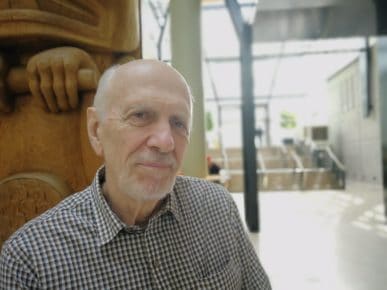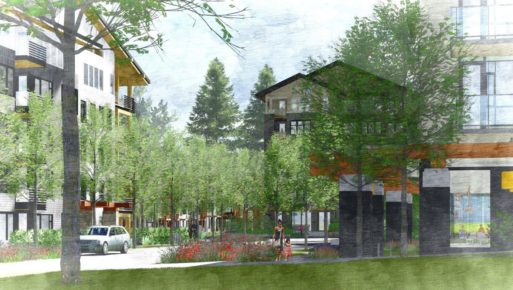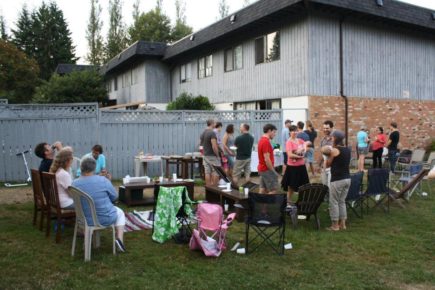The defining issue of Greater Vancouver is housing affordability – Lynn Valley is no exception. With the official community plan (OCP) calling for densification near town centres, our community is changing. Slowly two-story multi-family developments are being replaced with low and mid-rise buildings. We are moving from a 1970s, suburban, mountainside community to a full-fledged 2030 town centre. There is understandable nostalgia for the community of 50 years ago – but how do we best move forward to create a future Lynn Valley with diversity, inclusion and community at its heart?
Lynn Valley isn’t facing the question of a theoretical future – families, government, builders and advocates are wrestling with this now. Like other properties before it, Emery Village is facing redevelopment. Politicians and planners are working to meet the goals of the 2011 community plan – “For a sustainable future.” Families are facing displacement and the collapse of their community networks with little rental supply on the North Shore to fall back on. At the same time, developers are walking the tightrope of business goals, OCP requirements and real-world community needs.
The Doer
Looking to continue his community contributions, a former North Vancouver principal turned to housing advocacy after retirement. After starting as a committee member, Don Peters has spent the last eight years as chair of the Community Housing Action Committee (CHAC). The committee is a part of North Shore Community Resources and is made up of North Shore residents, representatives of community organizations and volunteers who are concerned about the lack of affordable, appropriate and adequate housing on the North Shore.
“I used to think that just adding more units would solve the problem – and that was before the housing crisis took off,” said Peters. “Prices aren’t going to come down. We can’t freeze development but what we can do is be very careful about the kinds of housing we approve.”

His committee is facing a time of intense challenges amid skyrocketing property prices throughout North Vancouver.
“My heart goes out to anyone evicted who happens to be living in rental accomodation that is ‘past its best before date,’” he said. “There is only so much rehabilitation to the units that makes sense before they need to be rebuilt. Emery Village is an example. Mountain Court before it – that kicked off the affordable housing strategy we are now in for the district.”
The result is tension between what the community is, what it will likely look like in the future and what needs to be done right now.
“We have to find a way to keep rents in line with what people earn – [so] that this community can be a place where teachers can live, where firefighters can live. We don’t want them taking their talents and community investments elsewhere and having to take that bridge in for work.”
Different municipalities throughout Vancouver have different policies defining affordable housing, but it is simplest to look at the definitions from the Canadian Mortgage and Housing Corporation that assert housing should cost no more than 30 percent of one’s gross income. The problem is that there is a big difference of what that means for a $20,000 income, a $40,000 income or even a $100,000 income, explains Peters, especially when there is little rental stock available, never mind affordable.
“There are encouraging signs,” said Peters. “I now see an appetite for housing solutions [from developers]. There are more duplex, triplex and gentle infill being proposed. They are working to extend the life of some buildings. We see a willingness to find a non-profit to partner with to manage affordable housing.”
There are no easy answers when families face eviction or displacement.
“We get the tension – how do we weigh the need for rental and the need to keep people in their homes? It is the toughest thing we do – the toughest thing we do,” said Peters. “And we talk about it, and debate it ourselves. We negotiate with a developer and ask for more and we push for more – and we are careful we don’t push so much a developer walks away. On this one we came down on it that they were going to add a significant number of rental units and they were going to make half of them below market rentals – and that carried the day.”
But he is well aware it is not perfect.
“We negotiate and support the best projects. Building new stock needs an accompanying solution – ideally there would be alternative housing during construction.”
The Developer
In 2016 Mosaic Homes bought the 1967, 61-unit Emery Village. Max Bruce, senior vice-president of income properties for Mosaic, has been working on this project from the start.
“We went in with an understanding these are families,” he said. “We had to understand their make-up.”
He says staff went on to meet with all residents and continue that on an ongoing basis. They collaborated with CHAC to understand its goals for the area. The result is a proposal that meets the OCP needs – but less then that maximum density allowed – while exceeding the current rental and affordable housing requirements.
“We are setting what could be a good model for future developments,” said Bruce. It is a big step forward, agrees Peters.
 “It is groundbreaking – this willingness to look after people,” said Peters. “To go from 61 rental units to 84 – to have that rental secured in perpetuity [some developers only guarantee rentals for a set time, typically five years before selling the units]. There is no way to stop rents from going up but Mosaic has committed to half being sub-market. As a result of our work with Mosaic we are going to be able to push other developers.”
“It is groundbreaking – this willingness to look after people,” said Peters. “To go from 61 rental units to 84 – to have that rental secured in perpetuity [some developers only guarantee rentals for a set time, typically five years before selling the units]. There is no way to stop rents from going up but Mosaic has committed to half being sub-market. As a result of our work with Mosaic we are going to be able to push other developers.”
dents of Emery Village who were tenants at the time of Mosaic’s purchase of the property – 50 families – have the first crack at purchasing or renting homes in the new development which will feature 411 units in total. Mosaic has a full-time coordinator working with families to secure housing in the meantime. Residents will also have three months free rent in addition to some compensation to ease the transition.
“We realize Lynn Valley is their community. We want them to move in their own time,” said Bruce. “Typically families have to stay right to the end to qualify – we are flexible and every one of those families is entitled to our offer.”
The close collaboration with CHAC and the understanding of families already led to some changes to the initial development Mosaic had in mind.
“There are trade-offs, some families may have smaller units,” he said. “But they are well-designed, energy efficient and will have more amenities – like in-suite laundry – than are there now. We have added five four-bedroom units that were not a part of the original design. In terms of the rents we came up – we went in and calculated all the rents of the residents there today, and if you look at the affordable rents that are there today and we matched it within in a very small margin. All of those affordable rents we are proposing for the 42 units are roughly equivalent to the rents Emery residents pay today.”
Bruce says that as a homegrown company, Mosaic is well aware of the housing challenges on the North Shore.
“This is providing much needed housing stock: concrete high-rise for empty nesters to age-in-place; wood-framed townhomes for families; wood-framed condominiums for singles or couples. We know local families need rentals. We know local businesses need rentals; they are missing opportunities because their staff can’t live here,” said Bruce. “Given that we are building more than exist in the community, we are actually increasing the supply of rental in the district and making it permanently affordable. Not only will the residents of emery will benefit but the broader community will benefit.”
The Displaced
The Bond family has been living in Emery Village for nine years. The family of six has seen their children grow and thrive at Emery.
“It reminds me of how I grew-up,” says Kelly Bond. “They are always out there running around – there is someone to keep an eye on the them. They are out there every day – getting so much exercise – playing capture the flag. It is important for their social development – and great connections for parents.”

An Emery Village barbecue
In the months leading up to the early 2016 sale of the complex, residents had their radar piqued that something was coming, says Bond. There was activity like surveying that indicated change was on the horizon. They were given official notice in October of that year.
“Some residents have been here 36-37 years,” said Bond. “Most are resigned to the fact this is going ahead. I knew it was a process. I have been able to educate residents in here and let them know that they still have a say, whether or not the approval is a foregone conclusion or not. Some have been through displacement of Mountain Court or Whiteley Court and cannot go through the fight again, some are resigned, and some don’t want to stir the waters.”
Bond has become a passionate and educated advocate for her family and her neighbours – she is using the notion that the best anti-displacement strategy is educating and empowering people that have been traditionally left out of the planning process and helping them shape the development of their community. In a highly-heated and emotional situation, she is calmly advocating, educating and calling for creative solutions. Knowing there is a possibility for families to come back (although she worries some will be left out, finding their incomes too low for new market rents but too high to qualify for affordable housing) at the crux of the matter is the temporary housing during the redevelopment.
“The options coming our way aren’t very helpful,” she said. “There is a big gap between what we are paying now – a minimum $800 jump. I don’t know if we will be able to stay on the North Shore.”
She is seeing a future disconnected from the community she has invested 25 years in.
“It’s heartbreaking when people are forced out,” said Peters. “It leaves them jagged. To see them leave the place they live and often work, it separates them from relationships, from their family doctor, from their pharmacist, from their churches. They are left commuting, not connecting.”
There are creative solutions to consider, says Bond.
“Let’s put a pause on the public hearing,” she said. “Senior levels of government have indicated there is money. Consider something like emergency modular housing. Ideally wait until there is temporary housing available. I question why there isn’t more affordable housing – but some [DNV] councillors say ‘If we give up some of the $12 million [Mosaic has offered $11.9 million in community amenity contributions] we will have to raise taxes on homeowners.’”
The majority of residents of Emery Village aren’t against Mosaic. They are dealing with the results of previous developments that did not balance the conflicting OCP goals of preserving rental housing while building up town centres. They want to bring forward the idea to preserve existing rental housing stock until other options are available. It’s a concept that wasn’t even considered when the OCP was created, she said.
“We have a supportive community here – I don’t see everyone returning but if we do once we are in a high rise we lose connections with our neighbours,” said Bond. “We have open doors and frequent chats – you don’t do that in a high-rise elevator. This is part of a growing city – and it’s sad.”
The Future
On April 16th DNV passed a motion moving the Emery Village project forward to public hearings. A move Bond is pleased that will allow more voices to heard – adding only four of 16 people representing tenants got to speak at the council meeting.
“If I could wave my magic wand I would want municipalites to revisit their housing strategies. Find a way for every single multi-family development built to have affordable housing,” said Peters. “For developers to come to the table with a Mosaic-like attitude – and a lot are. They get the need.”
Peters is optimistic more developers are in business with more good intentions. Governments seem willing to review its policies. And more members of the public are becoming engaged. He sees more small successes, finding ways to house people that happen quietly and with little fanfare.
“There isn’t a magical, instant solution,” said Peters. “I met with the mayor this morning and he feels like I do. We wish it wasn’t unfolding this way but maybe Kelly and others can find a small consolation they may have forced new thinking – new commitment.
“There will always be people who can’t compete financially. If we can’t house them, we lose them and the commitment to where they live and we will probably lose schools and the business they supported are going to suffer. Everything is connected,” he said. “A good healthy community is not afraid to renew but it has to look after those that have brought us this far.”
LynnValleyLife.com will post information on the hearings as it becomes available.


